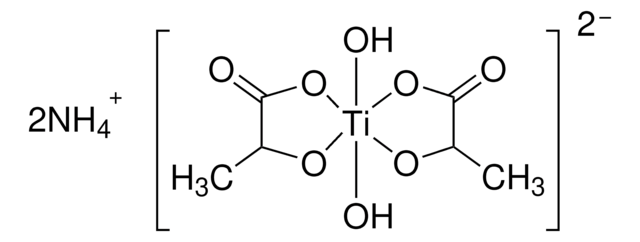325252
Titanium diisopropoxide bis(acetylacetonate)
75 wt. % in isopropanol
Synonym(s):
Diisopropoxytitanium bis(acetylacetonate) solution, TYZOR® AA organic titanate, Ti(acac)2OiPr2
About This Item
Recommended Products
form
solution
Quality Level
composition
Ti, 9-10.5% gravimetric
reaction suitability
core: titanium
reagent type: catalyst
concentration
75 wt. % in isopropanol
refractive index
n20/D 1.4935
density
0.995 g/mL at 25 °C
SMILES string
CC(C)O[Ti](OC(C)C)(O\C(C)=C\C(C)=O)O\C(C)=C\C(C)=O
InChI
1S/2C5H8O2.2C3H7O.Ti/c2*1-4(6)3-5(2)7;2*1-3(2)4;/h2*3,6H,1-2H3;2*3H,1-2H3;/q;;2*-1;+4/p-2/b2*4-3+;;;
InChI key
OVSGBKZKXUMMHS-VVDZMTNVSA-L
Looking for similar products? Visit Product Comparison Guide
Application
Legal Information
Signal Word
Danger
Hazard Statements
Precautionary Statements
Hazard Classifications
Eye Dam. 1 - Flam. Liq. 2 - STOT SE 3
Target Organs
Central nervous system
Storage Class Code
3 - Flammable liquids
WGK
WGK 3
Flash Point(F)
53.6 °F - closed cup
Flash Point(C)
12 °C - closed cup
Personal Protective Equipment
Choose from one of the most recent versions:
Already Own This Product?
Find documentation for the products that you have recently purchased in the Document Library.
Customers Also Viewed
Articles
New methods for materials fabrication at the micro- and nanoscale will drive scientific and technological advances in areas of materials science, chemistry, physics, and biology. The broad diversity of potentially relevant materials, length scales, and architectures underscores the need for flexible patterning approaches. One important example is the fabrication of 3D periodic structures composed of colloidal, polymeric, or semiconductor5 materials.
Titanium dioxide (TiO2) is an important n-type semiconducting material that shows interesting characteristics such as photoswitchable surface wettability, high photocatalytic activity, bistable electrical resistance states and high electron drift mobility.
Few Monolayer Atomic Layer Deposition (ALD) on Surfaces and Interfaces for Energy Applications
A Review of Mesoporous TiO2 Thin Films
Global Trade Item Number
| SKU | GTIN |
|---|---|
| 325252-500ML | 4061838253231 |
| 325252-5ML | |
| 325252-100G | |
| 325252-100ML | 4061826712801 |
| 325252-500G |
Our team of scientists has experience in all areas of research including Life Science, Material Science, Chemical Synthesis, Chromatography, Analytical and many others.
Contact Technical Service












